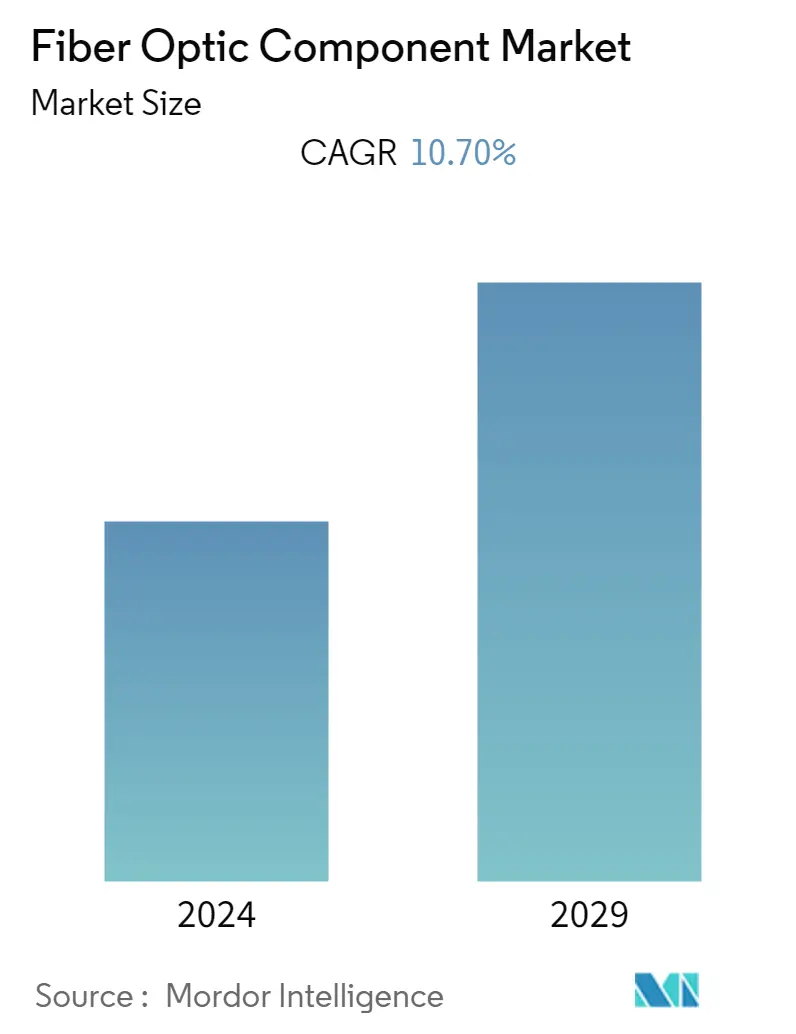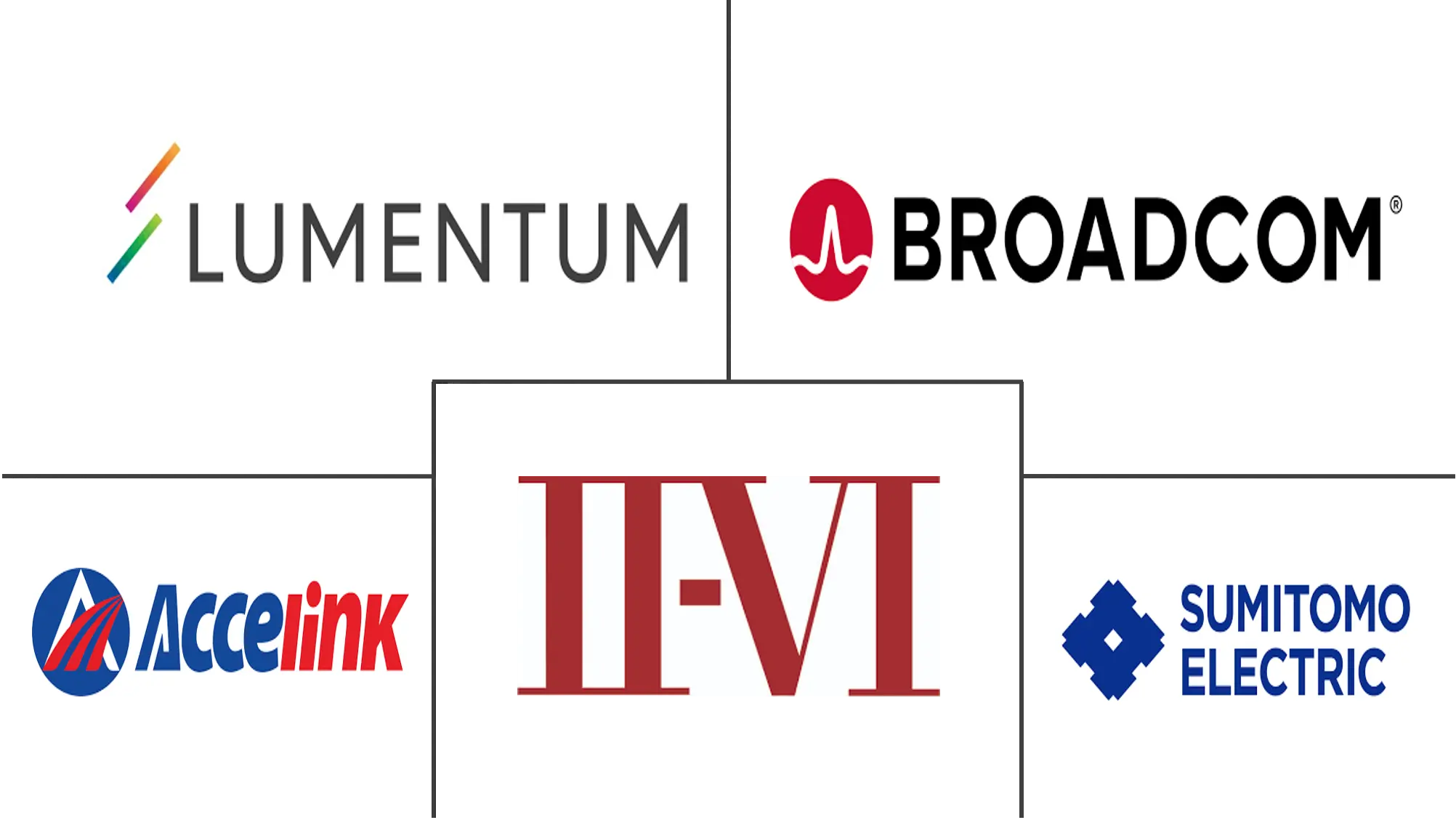Market Size of Fiber Optic Component Industry

| Study Period | 2019 - 2029 |
| Base Year For Estimation | 2023 |
| CAGR | 10.70 % |
| Fastest Growing Market | Asia Pacific |
| Largest Market | Asia Pacific |
| Market Concentration | Low |
Major Players
*Disclaimer: Major Players sorted in no particular order |
Fiber Optic Components Market Analysis
The Fiber Optic Component Market is expected to grow at a CAGR of 10.7% over the forecast period 2021 to 2026. This market's growth is propelled by the increasing deployment of data centers, growing internet penetration and data traffic, rising demand for bandwidth and reliability, and developments in the fiber optic components ecosystem.
- With the growing requirement for IoT and more connected devices, data transmission has become essential. According to Forbes, the total installed base of the Internet of Things (IoT) connected devices is projected to amount to 75.44 billion worldwide by 2025, a fivefold increase in ten years. Consequently, the fiber optic component market is observing a significant opportunity for growth during the forecast period.
- Further, technological advancements in the telecom sector have increased the deployment of broadband network architectures. Fiber to the Home (FTTH) and Fiber to the Building (FTTB) are the few prominent broadband networking architectures that necessitate the large-scale deployment of fiber optic networks, hence fiber optic components, thus, driving the fiber optic component market growth.
- Among all the types in the fiber optic components, the market for the transceiver is expected to hold the largest share. Major factors driving the fiber optic components market for transceivers include the higher interconnect capability and high-speed data transmission. For instance, as per Cisco Systems, the average mobile connection speed stood at an estimated 17.7 Mbps worldwide in 2020 against 6.8 Mbps in 2016 and is expected to reach 20.4 Mbps in 2021 globally.
- Moreover, the introduction and adoption of new applications such as wearable devices, IoT, and cloud computing address the change in the needs of consumers. According to the Cisco Visual Networking Index, the number of connected wearable devices worldwide has more than doubled in three years, increasing from 325 million in 2016 to 722 million in 2019. The number of devices is forecast to reach more than one billion by 2022. Hence, the fiber optic component market has been witnessing a considerable opportunity for growth during the forecast period.
- The increasing internet penetration and data traffic are leading to the rapid growth of data centers and the need for high-speed transmission networks, thus fueling the Fiber Optic Component Market. For instance, Cisco Systems forecast that by 2021, there will be 7.2 million data centers in the world, which has generated an ever-greater amount of data and it is projected that by 2021, around 1,327 EB data would be stored in data centers - almost an 8-fold increase from 2015, thus boosting the demand for fibre optic components.
- Among various applications, the communications application accounted for the most significant share of the overall fiber optic components market. The growth of this market can be attributed to the mass utilization of digital technologies and applications in telecommunications, data centers, and enterprises.
- With all this development in the communications application, the demand for fiber optic components would also rise. However, difficulty in managing the failure of passive optical networks (PON) and less range of network devices connection are restraining the growth of this market.
Fiber Optic Components Industry Segmentation
The components that form the fiber optic networking system are called fiber optic components. Fiber optic components are becoming the core of the telecommunication industry, and advancements in cabling technology have resulted in the significant growth of fiber optic components. Typical fiber optic components include coupler/splitters, transceivers, WDM multiplexer, optical circulator, amplifier, filter, isolator, and various other functional modules.
| By Type** | |
| Cables | |
| Amplifiers | |
| Active Optical Cables | |
| Splitters | |
| Connectors | |
| Transceivers | |
| Other Types |
| By Application | |
| Distributed Sensing | |
| Communications | |
| Analytical and Medical Equipment | |
| Lighting |
| Geography | ||||||
| ||||||
| ||||||
| ||||||
| Rest of the World |
Fiber Optic Component Market Size Summary
The Fiber Optic Component Market is experiencing robust growth, driven by the increasing demand for high-speed data transmission and the expansion of internet connectivity. The proliferation of IoT devices and the necessity for enhanced bandwidth and reliability are key factors propelling this market. Technological advancements in the telecommunications sector, such as the deployment of Fiber to the Home (FTTH) and Fiber to the Building (FTTB) architectures, are further stimulating the demand for fiber optic components. Among the various types of fiber optic components, transceivers are expected to dominate the market due to their superior interconnect capabilities and high-speed data transmission features. The rise of new applications, including wearable devices, IoT, and cloud computing, is also contributing to the market's expansion, as these technologies require robust and efficient data transmission solutions.
The Asia Pacific region is anticipated to hold the largest market share for fiber optic components, supported by rapid industrialization and infrastructural advancements. The region's growing number of fixed broadband subscribers and the increasing demand for faster network connectivity are significant drivers of market growth. Governments in developed countries like China and Japan are investing in high-speed networks, transitioning from traditional to FTTH networks, which is expected to further boost the market. The fiber optic component market is characterized by fragmentation, with major players engaging in strategies such as expansions, partnerships, and new product launches to strengthen their market presence. Notable companies in this space include Lumentum Operations LLC, II-VI Incorporated, and Broadcom Corporation, among others, who are actively working to enhance their offerings and capture a larger share of the market.
Fiber Optic Component Market Size - Table of Contents
-
1. MARKET DYNAMICS
-
1.1 Market Overview
-
1.2 Marker Drivers
-
1.2.1 Growing Deployment of Data Centers
-
1.2.2 Increasing Internet Penetration and Data Traffic
-
1.2.3 Intensifying Demand for Bandwidth and Reliability
-
-
1.3 Market Challenges
-
1.3.1 Susceptible to Physical Damage and Transmission Loss
-
1.3.2 Threat to Optical Network Security
-
-
1.4 Market Opportunities
-
1.5 Industry Attractiveness - Porter's Five Forces Analysis
-
1.5.1 Bargaining Power of Suppliers
-
1.5.2 Bargaining Power of Buyers/Consumers
-
1.5.3 Threat of New Entrants
-
1.5.4 Threat of Substitute Products
-
1.5.5 Intensity of Competitive Rivalry
-
-
1.6 Industry Value Chain Analysis
-
1.7 Impact of COVID-19 on the Fiber Optic Component Market
-
-
2. MARKET SEGMENTATION
-
2.1 By Type**
-
2.1.1 Cables
-
2.1.2 Amplifiers
-
2.1.3 Active Optical Cables
-
2.1.4 Splitters
-
2.1.5 Connectors
-
2.1.6 Transceivers
-
2.1.7 Other Types
-
-
2.2 By Application
-
2.2.1 Distributed Sensing
-
2.2.2 Communications
-
2.2.3 Analytical and Medical Equipment
-
2.2.4 Lighting
-
-
2.3 Geography
-
2.3.1 North America
-
2.3.1.1 United States
-
2.3.1.2 Canada
-
-
2.3.2 Europe
-
2.3.2.1 United Kingdom
-
2.3.2.2 Germany
-
2.3.2.3 France
-
2.3.2.4 Rest of Europe
-
-
2.3.3 Asia Pacific
-
2.3.3.1 China
-
2.3.3.2 Japan
-
2.3.3.3 India
-
2.3.3.4 Rest of Asia Pacific
-
-
2.3.4 Rest of the World
-
-
Fiber Optic Component Market Size FAQs
What is the current Fiber Optic Component Market size?
The Fiber Optic Component Market is projected to register a CAGR of 10.70% during the forecast period (2024-2029)
Who are the key players in Fiber Optic Component Market?
Lumentum Operations LLC, II-VI Incorporated, Broadcom Corporation, Sumitomo Electric Industries, Ltd. and Accelink Technologies Corporation are the major companies operating in the Fiber Optic Component Market.

